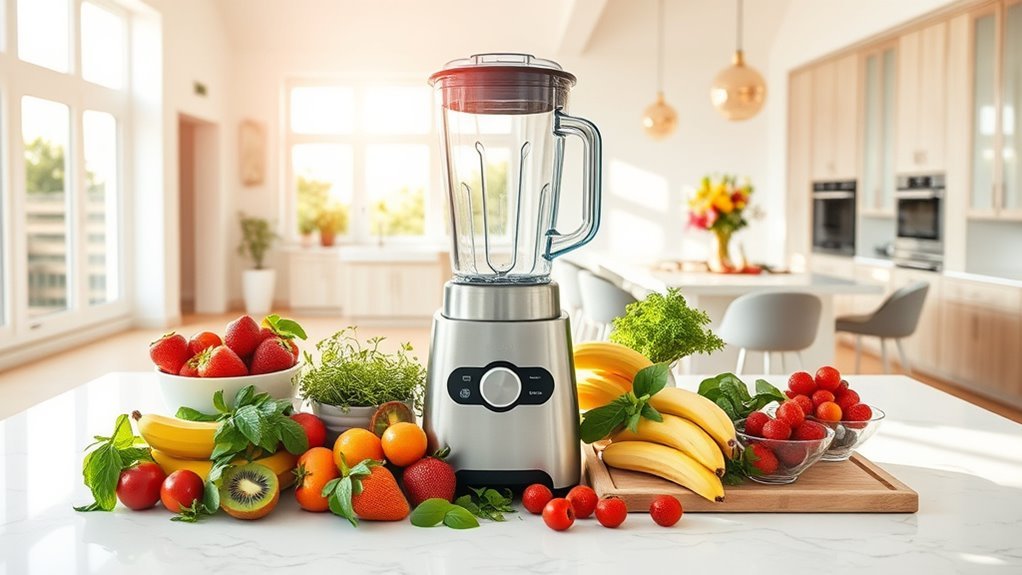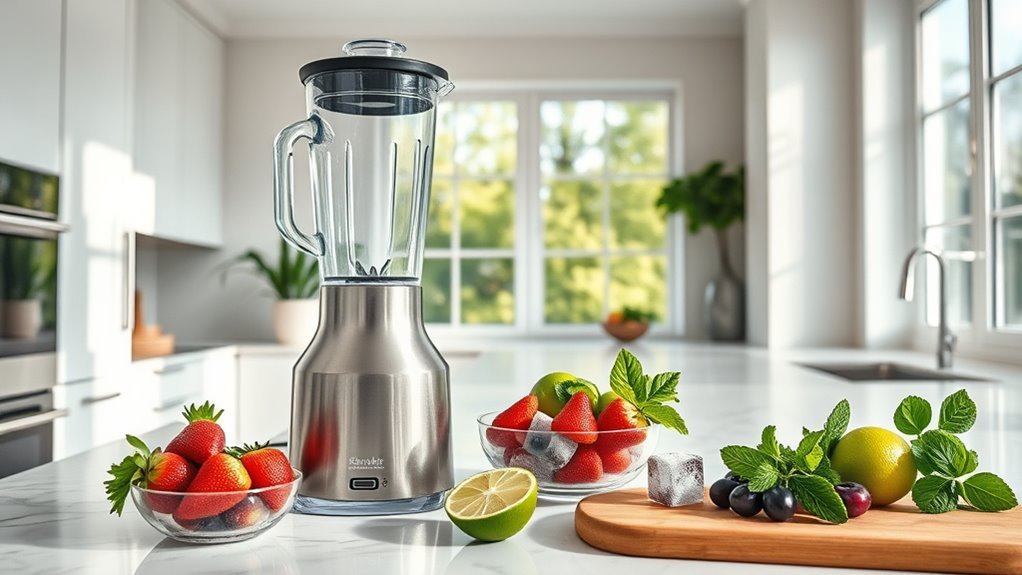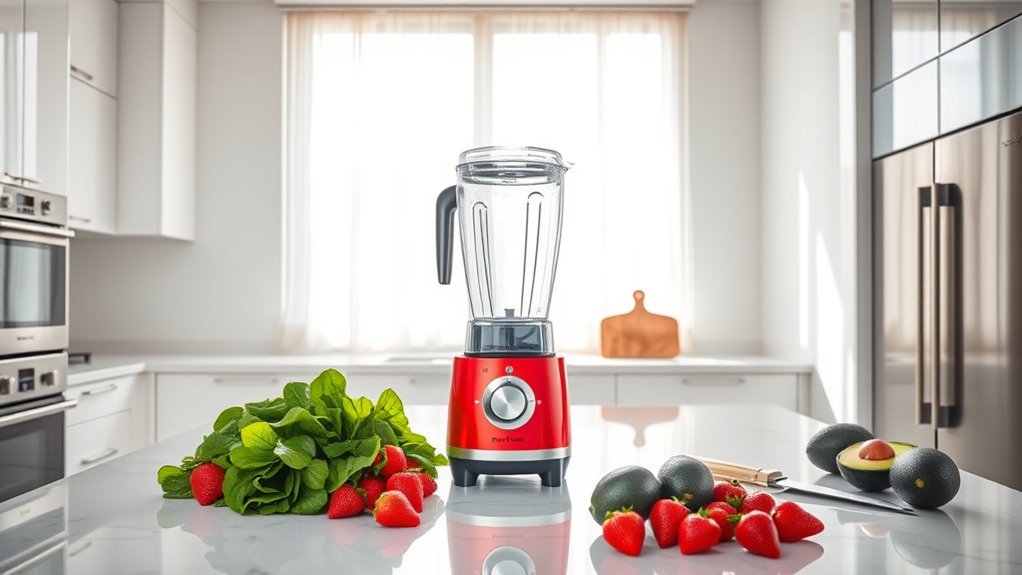I’ve spent countless hours testing blender attachments, and we’ve found that the right blade can make or break your kitchen experience. Cross blades work wonders for smoothies, while flat blades transform nuts into perfect flour. What’s interesting is how immersion blenders have evolved – they’re not just stick blenders anymore! With whisks for creams and specialized choppers for herbs, the line between countertop and immersion models is blurring. So what should you actually look for when comparing options?
Common Blade Designs for Countertop Blenders

When it comes to countertop blenders, we’re often overlooking what’s actually doing all the work—those powerful blades spinning around at the bottom of the jar.
Different types of blenders feature distinct blade configurations designed for specific tasks.
Cross blades are the workhorses we rely on for tasks like pureeing soups and blending smoothies to silky perfection.
For tougher ingredients like nuts or spices, flat blades provide the grinding power needed.
And those serrated edges? They’re specifically designed to crush ice for your frozen margaritas.
Many countertop blenders now include hybrid designs that handle both fibrous ingredients and harder materials.
We’ve found that stainless steel blades offer the best durability—I mean, they’re constantly battling everything from frozen fruits to tough vegetable fibers, right.
High-performance blenders often incorporate sharper blades to ensure they can effortlessly tackle even the toughest ingredients like nuts for superior results.
Specialized Attachments for Immersion Blenders
Unlike countertop blenders that stay in one place, immersion blenders have revolutionized how we approach kitchen tasks with their versatile attachments.
Hand blenders today come with an impressive array of additional features.
We’ve found the whisk attachment particularly useful for cream or beating egg whites to perfect peaks.
Many models offer interchangeable blades and chopper attachments, transforming your simple hand blender into a complete food chopper system.
What’s really nice—actually, what’s amazing—is how some premium immersion blenders include multiple speed settings (KitchenAid offers up to nine!), making them perfect for everything from emulsifying salad dressings to preparing smooth baby food.
I think the blending cups that come with some models are probably the most convenient for quick smoothies.
This versatile tool truly deserves a spot in every kitchen.
Additionally, some immersion blenders now include motor power capabilities that enhance their ability to handle tough ingredients efficiently, much like high-performance models.
Multi-Purpose Blades for Smoothies and Ice Crushing

Why are we suddenly seeing so many blenders with multi-purpose blades on the market?
It’s simple – today’s consumers want versatile appliances that can handle multiple tasks without sacrificing performance.
These specialized blades, like serrated ones with jagged edges, are designed to crush ice while also blending soft ingredients into smooth smoothies.
We’re particularly impressed with cross blades, which provide that broad cutting surface needed for both pureeing and ice crushing.
In hand blenders, hybrid blades combine blending and whisking functions – perfect for making smoothies from frozen fruits or even homemade ice cream!
The best multi-purpose blades are typically found in models with higher wattage (at least 1000 watts), like the Vitamix Explorian.
Their advanced engineering prevents dulling when working with tough ingredients, making them truly worth the investment.
Food Processing Accessories Across Blender Types
Multi-purpose blades are just the beginning when it comes to making blenders truly versatile.
When we look at the different types of blenders available, each offers unique food processing accessories that expand their functionality beyond basic blending.
Immersion blenders shine with their interchangeable attachments – you can puree soup right in the pot, then switch to chopping meat with the same device.
Traditional blenders and personal blender models often include specialized cups for different purposes.
Food processors, which many consider a type of blender, come with impressive attachments for kneading dough or grating vegetables.
We’re particularly impressed by advanced Kitchen Appliances like the Thermomix that combine multiple functions in one.
It’s amazing how a simple attachment swap can transform your blender from a smoothie maker to a complete food processor system!
Comparing Blade Materials and Durability Features

Every experienced home chef knows that a blender is only as good as its blades.
When Choosing the Best blender for your kitchen, Look for durable stainless steel blades designed to handle everything from smoothies to nut butters.
We’ve found that serrated blades with jagged edges are particularly effective for crushing ice, while cross blades offer versatility for different foods.
While Plastic jars might be lightweight and affordable, they’re only practical when paired with high-quality metal blades.
The right choice really depends on what you’ll be blending most often.
In our experience, flat blades made from high-grade stainless steel work wonderfully for grinding spices, but you’ll need sufficient motor strength to power through tougher ingredients.
Hybrid blades are great if you’re looking for a multi-purpose option.
Frequently Asked Questions
What Are the Different Types of Blender Blades?
We blend, we grind, we crush with various blade shapes: cross patterns for pureeing, flat blades for grinding, serrated edges for ice, multi-level for efficiency, and single-tier for simplicity—all in durable materials.
Do All Ninja Blenders Use the Same Blade?
No, we’ve found that Ninja Blades lack uniformity across their Models. Through our Ninja Analysis, we’ve observed significant Series Variations affecting Blade Consistency, Compatibility, and Replacement Parts as Model Evolution continues through Upgrade Differences.
What Are the Different Types of Blenders and Their Uses?
We’ve got several blender types: high-speed countertops for kitchen integration, travel-friendly personal designs, handheld immersion styles for direct-pot blending, battery-powered varieties, and commercial models offering superior smoothie efficiency.
What Are the Options on a Blender?
80% of consumers consider multiple features when buying blenders. We’ll help you navigate speed settings, power levels, container sizes, cleaning methods, safety features, timer functions, color options, warranty periods, noise levels and energy efficiency.

